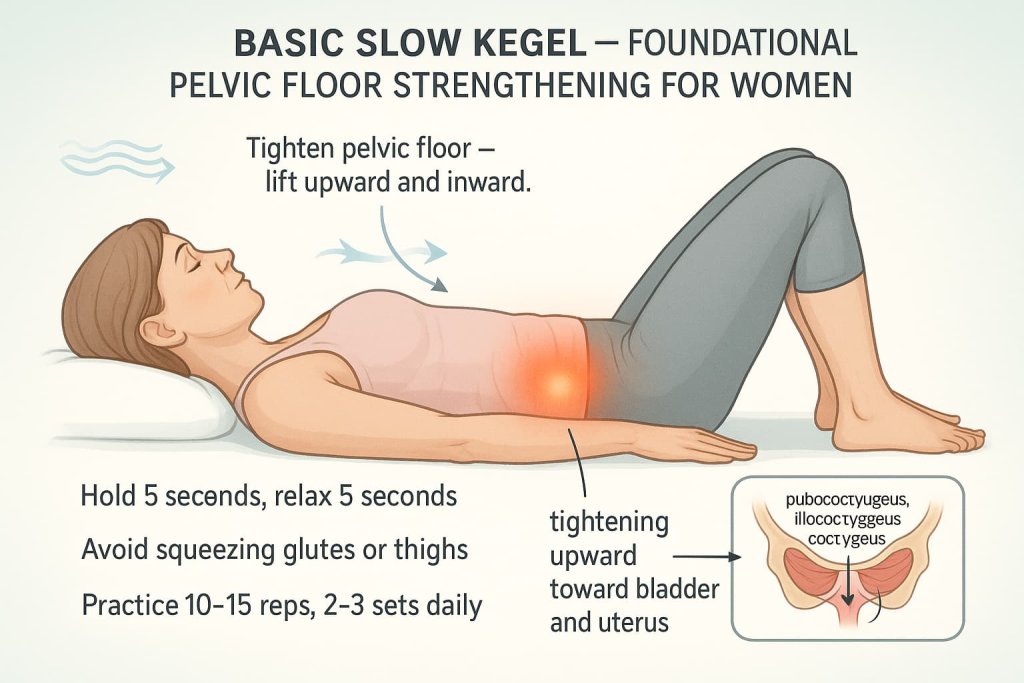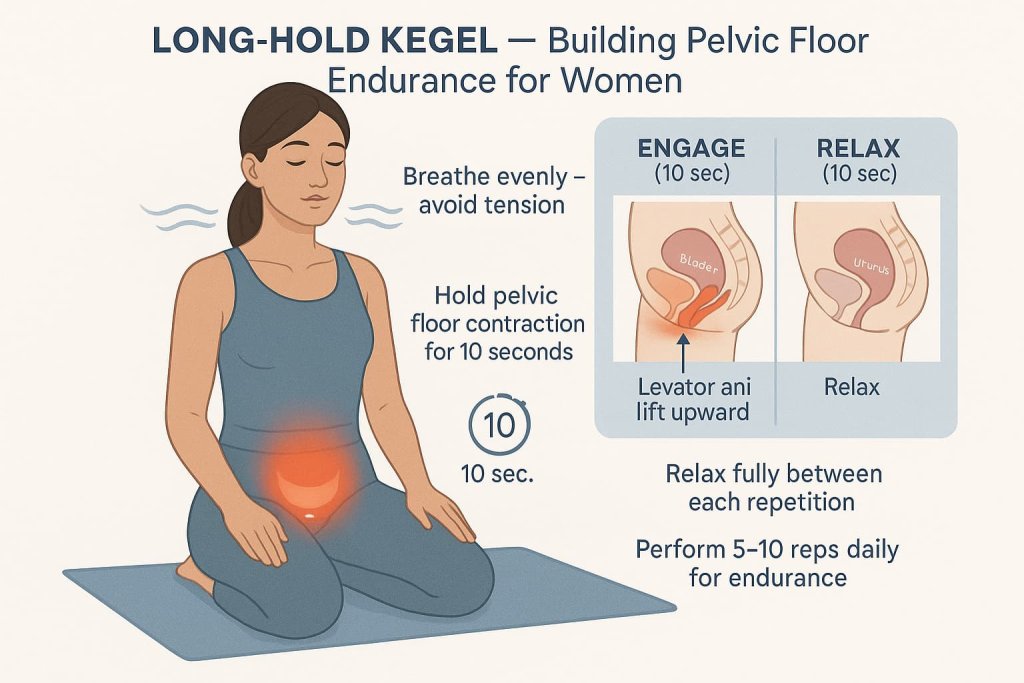If you’re a woman experiencing bladder leaks, pelvic pressure, or a weak core, you’ll be glad to know that Kegel Exercises for Women can make a remarkable difference.
These simple yet powerful movements help strengthen the pelvic floor muscles — the deep layers of support that hold up your bladder, uterus, and bowel. When trained correctly, they enhance posture, improve stability, and restore confidence in daily life.

Performed consistently, Kegel exercises may help reduce urinary leakage, support recovery after childbirth, and prevent pelvic organ prolapse.
What makes them even more empowering is that they’re discreet, equipment-free, and clinically proven to work. Research shows that structured pelvic floor muscle training (PFMT) for 8–12 weeks can significantly improve continence and pelvic support in women (BMC Women’s Health, 2022).
Why Kegel Exercises Matter for Women
A strong pelvic floor is fundamental to every woman’s health and confidence. Whether you’re postpartum, approaching menopause, or simply seeking better body control, Kegel Exercises for Women support the muscles that stabilize your pelvis and core — the foundation for movement, continence, and intimacy.

Key Benefits Supported by Research
- Improved Bladder Control:
Regular pelvic floor muscle training can reduce urinary leakage by up to 70% in women with mild incontinence (Cochrane Review, 2018). - Enhanced Postpartum Recovery:
Strengthening the pelvic floor after childbirth aids tissue healing and restores internal support, often within 8–12 weeks. - Support Against Pelvic Organ Prolapse:
PFMT helps prevent or slow prolapse progression by improving muscular lift and tension (NICE Guideline NG123, 2019). - Better Core Stability & Posture:
The pelvic floor works in synergy with the diaphragm and abdominal muscles, creating balanced intra-abdominal pressure for spine and hip stability. - Increased Sexual Wellness:
Improved muscle tone and circulation may enhance sensation and control, contributing to greater sexual confidence.
How to Find Your Pelvic Floor Muscles

Before you begin:
- Locate the right muscles: While urinating, try to stop the flow mid-stream (do this once only for identification).
- Feel the internal lift: That gentle upward tightening is your pelvic floor.
- Avoid squeezing your abs, glutes, or thighs — the movement should be internal.
- Breathe normally — never hold your breath.
Once you can identify the correct muscles, practice regularly in lying, sitting, or standing positions.
The 10 Best Kegel Exercises for Women
These 10 Kegel Exercises for Women target every level — from beginners rebuilding strength to advanced users improving endurance and control. Practice them consistently for 5–10 minutes daily to enhance bladder control, posture, and overall pelvic health.
1. Basic Slow Kegel
Why it works:
This foundational move develops the ability to consciously contract and relax your pelvic floor. Slow, deliberate holds build endurance and strength in the deep stabilizing muscles that support your bladder and uterus. Over time, this helps prevent urinary leakage and enhances overall pelvic control — the cornerstone of any Kegel routine.
Muscles worked:
Pubococcygeus, iliococcygeus, and coccygeus (collectively forming the levator ani group).

How to do it:
- Sit or lie down comfortably with knees bent.
- Gently contract your pelvic floor muscles — imagine lifting them inward and upward.
- Hold for 5 seconds, then fully relax for 5 seconds.
- Perform 10–15 repetitions, completing 2–3 sets daily.
Trainer Tip:
Picture lifting a marble gently inside your pelvis. Keep your abdomen, glutes, and thighs relaxed to isolate the correct muscles.
2. Quick Pulse Kegel
Why it works:
This variation enhances your pelvic floor’s responsiveness. It targets fast-twitch muscle fibers responsible for instant tightening during activities like coughing, sneezing, or jumping. Improved reactivity helps reduce stress incontinence and sharpens muscle coordination.
Muscles worked:
Fast-twitch fibers of the pelvic diaphragm, particularly the bulbocavernosus and pubococcygeus.
How to do it:
- From a relaxed seated or lying position, rapidly tighten and release your pelvic floor muscles.
- Contract for 1 second, release for 1 second.
- Complete 20 repetitions in a row.
- Perform 1–2 sets per day.
Trainer Tip:
Think of this as a “quick snap,” not a long squeeze. Maintain smooth breathing throughout the sequence.
3. Long-Hold Kegel
Why it works:
Holding contractions for longer durations develops muscular endurance, allowing your pelvic floor to sustain support throughout daily activities. This is especially beneficial for women experiencing mild pelvic organ prolapse or bladder leakage during long periods of standing.
Muscles worked:
Levator ani group and deep stabilizers of the pelvis.

How to do it:
- Contract your pelvic floor and hold for 10 seconds.
- Relax completely for 10 seconds before repeating.
- Perform 5–10 repetitions per session, once daily.
Trainer Tip:
Start with 5-second holds if needed, and gradually extend duration as control improves. Always release fully between reps to avoid tension buildup.
4. Bridge with Kegel
Why it works:
Combining the bridge pose with a Kegel adds resistance from the hips and glutes, increasing overall pelvic stability. This integration mimics real-life postural support, especially useful for postpartum recovery and core balance.
Muscles worked:
Gluteus maximus, hip extensors, and the entire pelvic floor.
How to do it:
- Lie on your back with knees bent and feet flat, hip-width apart.
- Lift hips slowly into a bridge position.
- Engage your pelvic floor muscles at the top for 3–5 seconds, then lower your hips.
- Repeat 10 times.
Trainer Tip:
Avoid arching your back — maintain a neutral spine. Focus on lifting your hips with control, not momentum.
5. Seated Kegel
Why it works:
Practicing Kegels in a seated position enhances awareness of core engagement and allows for convenient daily training. This is ideal for women with desk jobs or those who want a discreet way to maintain pelvic health.
Muscles worked:
Deep pelvic floor muscles, particularly the pubococcygeus.
How to do it:
- Sit tall with your feet flat on the floor and spine straight.
- Contract your pelvic floor and hold for 5 seconds.
- Relax for 5 seconds, ensuring full release.
- Perform 10–15 repetitions.
Trainer Tip:
Imagine drawing your pelvic floor upward toward your navel. Keep shoulders relaxed and avoid clenching your thighs or glutes.
6. Standing Kegel with Heel Raise
Why it works:
This functional move strengthens your pelvic floor while training balance and posture. The heel raise activates lower-leg stabilizers, reinforcing coordination between your feet, hips, and pelvic base.
Muscles worked:
Pelvic floor, calves (gastrocnemius, soleus), and core stabilizers.
How to do it:
- Stand with feet hip-width apart.
- Engage your pelvic floor while lifting your heels slowly off the floor.
- Hold both contractions for 3 seconds, lower, and relax.
- Repeat 10–12 times.
Trainer Tip:
Keep your breathing steady. Inhale as you lower your heels, exhale during the lift and pelvic engagement.
7. Bird-Dog Kegel
Why it works:
This dynamic variation challenges core stability, balance, and coordination. By combining limb extension with pelvic engagement, you train the pelvic floor to stay active during movement — critical for posture and back support.
Muscles worked:
Pelvic floor, transverse abdominis, erector spinae, and gluteus medius.
How to do it:
- Begin on hands and knees (tabletop position).
- Extend your right arm forward and left leg back while engaging your pelvic floor.
- Hold for 5 seconds, return to start, and switch sides.
- Perform 8 reps per side.
Trainer Tip:
Avoid shifting your hips or arching your back. Imagine maintaining a straight tabletop while lifting your limbs.
8. Wall Squat with Kegel
Why it works:
Combining a squat with pelvic-floor activation builds strength through multiple planes. It’s effective for improving lower-body tone and enhancing pelvic control during daily movements like sitting or lifting.
Muscles worked:
Quadriceps, glutes, and pelvic floor muscles.
How to do it:
- Stand with your back against a wall, feet about one foot forward.
- Slide down into a half-squat (knees above ankles).
- Engage your pelvic floor for 5 seconds, then relax for 5 seconds.
- Perform 8–10 repetitions.
Trainer Tip:
Keep knees aligned with toes and avoid rounding the lower back. Focus on lifting your pelvic floor upward as you hold the squat.
9. Side-Lying Kegel with Hip Lift
Why it works:
This exercise links the pelvic floor with hip abductors, enhancing lateral stability and pelvic alignment. It’s especially beneficial for women recovering from childbirth or dealing with hip imbalance.
Muscles worked:
Gluteus medius, minimus, and pelvic floor stabilizers.
How to do it:
- Lie on one side, knees bent and hips stacked.
- Lift your top knee slightly while contracting your pelvic floor.
- Hold for 3–4 seconds, then relax.
- Complete 10 reps per side.
Trainer Tip:
Keep your hips stacked directly on top of each other — no rolling backward. The movement should be small and controlled.
10. Weighted Kegel (Advanced)
Why it works:
Once you’ve built solid control, adding light resistance with a vaginal cone or weight increases muscle challenge. This method boosts strength, proprioception, and long-term continence outcomes — but must be done correctly to avoid strain.
Muscles worked:
Deep pelvic floor, pubococcygeus, and supporting fascia.

How to do it:
- Insert a clean, light vaginal weight or cone (under medical supervision).
- Contract pelvic floor muscles to hold it in place for 1–2 minutes.
- Relax fully and remove.
- Repeat 2–3 rounds.
Trainer Tip:
Start with minimal weight and shorter durations. Always seek guidance from a pelvic-floor physiotherapist before progressing.
Related:
Progression and Frequency
- Beginners: 3 sets daily (10 reps per set).
- Intermediate: Add bridge and standing variations 3–4 days/week.
- Advanced: Include dynamic moves (bird-dog, wall squat).
- Expect results within 6–12 weeks of consistent training.
Common Mistakes to Avoid
- Holding your breath or bearing down.
- Using your abs, glutes, or thighs instead of the pelvic floor.
- Doing too many contractions without full relaxation.
- Practicing while urinating (can cause infection).
- Expecting instant results — consistency is key.
Who Should (and Should Not) Do Kegel Exercises
Recommended for:
- Postpartum women
- Women during or after menopause
- Those with mild bladder leaks
- Anyone seeking improved core stability or posture
Avoid or seek medical advice if:
- You feel pelvic pain or tightness
- You’ve been diagnosed with a hypertonic pelvic floor
- You experience worsening symptoms after Kegel training
In such cases, consult a pelvic-floor physical therapist.
Trainer Tips
- Visualize “lifting” the pelvic floor upward like an elevator.
- Practice consistency: set phone reminders or pair with daily habits.
- Focus equally on contraction and relaxation.
- Use biofeedback or a pelvic-floor app for guidance.
- Combine with breathing and light core exercises for best results.
FAQ
1. How long before I see results?
Usually 4–6 weeks for mild improvement, 8–12 weeks for major changes.
2. Can Kegels improve sexual function?
Yes — stronger pelvic muscles can enhance sensation and control, but results vary.
3. Are Kegels safe during pregnancy?
Yes, with your doctor’s approval. They can prepare muscles for childbirth.
4. Should I do Kegels every day?
Yes — daily consistency ensures lasting strength and control.
5. Can you overtrain your pelvic floor?
Yes. Over-tightening without relaxation can cause discomfort. Balance contraction and rest.
6. Do I need equipment?
No. Weighted cones or trainers are optional — not required.
7. When should I see a therapist?
If you have pain, prolapse symptoms, or persistent incontinence after 3 months.
Conclusion
Kegel exercises are one of the most powerful, science-backed ways for women to strengthen their pelvic floor, prevent leakage, and rebuild confidence.
You don’t need a gym or equipment — just consistency and correct form. Start with the basics, practice daily, and notice improvements in posture, control, and comfort over time.
Take charge of your pelvic health today — a few minutes a day can make a lasting difference.
Disclaimer:
This content is for informational purposes only and not medical advice. Always consult a healthcare professional before starting any new exercise program, especially after surgery or if you experience pain.
References
- NICE Guideline NG123 — Urinary incontinence and pelvic organ prolapse in women: management
- Cochrane Review — Pelvic floor muscle training for urinary incontinence in women
- International Continence Society (ICS) — Public Fact Sheets: Pelvic Floor Muscle Training
- BMC Women’s Health — Mechanisms of pelvic floor muscle training for managing urinary incontinence (scoping review)
